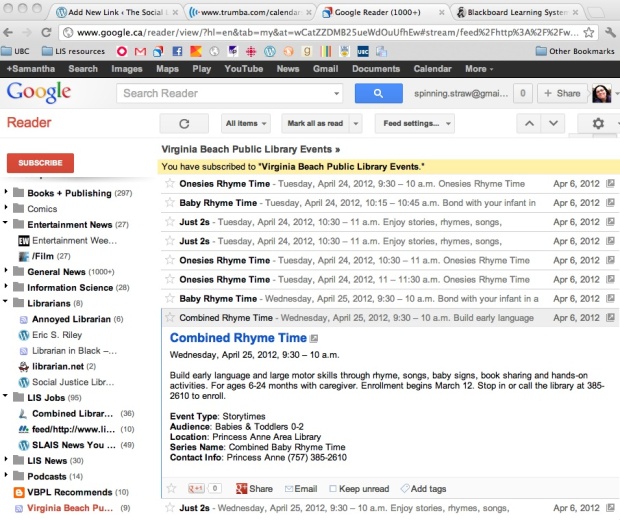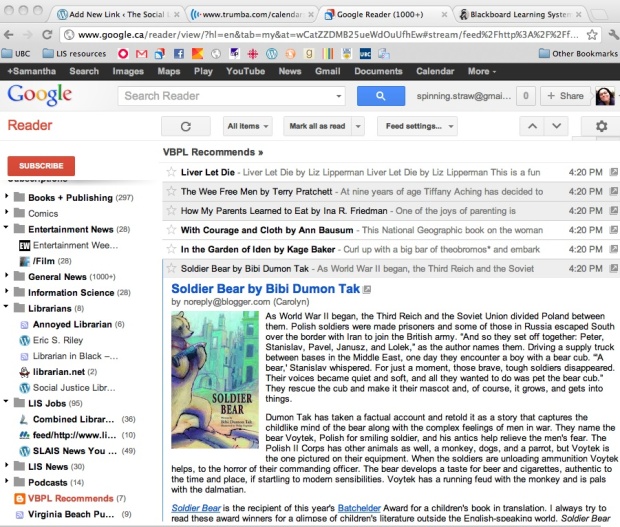Nicholas Senn High School Library’s Blog
“Nicholas Senn H. S. Library: 24/7: Promoting lifelong reading and learning one post at a time”
The Nicholas Senn High School Library blog is the library’s webpage, so navigability isn’t really an issue. However, if a user were coming from the NSHS main webpage, they would probably be out of luck – as far as I can tell, there is no direct link between the two, not even once you navigate from Main > Students > Library. Even a keyword search for “blog” turns up nada. And that goes also for the blog itself – nowhere on it is there a link to the school’s main page, although it is obvious from a perusal of the blogger’s profile page (which identifies her as a teacher-librarian in Chicago) as well as the links down the left side of the blog (which indicate that this is the same Nicholas Senn High School which is International Baccalaureate accredited). It seems as though you have to know about this blog in order to make use of it – which, since it is targeted at a highschool community rather than the general public, this is not necessarily a bad thing. Word spreads quickly in a highschool – if this blog is a useful resource, which it seems to be, then chances are most students know about it.
Turning to the blog’s content: the teacher-librarian who runs this blog is definitely making good use of its functionality. It is updated frequently, with posts appropriate to the mission of a school library: it provides information and links about school events, library services, and IT services within the school. It celebrates student achievements, such as participation in the recent Would You Survive the “Hunger Games” contest in which one of NSHS’s students finished second. And it provides academic tips as well: Learn How to Google to the Max is one example. Notably, it also takes great pains to celebrate teen culture and teen identity with posts like Happy Teen Tech Week, which celebrates “geeks”, and Ten Steps to Smart Phone Privacy. The blog also makes decent use of tagging, with the centralized authority of just one poster (the teacher-librarian) ensuring that tags get used repeatedly and create connections among posts. Clicking on “book-to-movie” under posts about The Hunger Games takes the user back to old posts about Twilight, and similarly clicking on “games” takes the user to a whole long list of posts about games and gaming.
The tags and the blog archive definitely create space for users to browse and make serendipitous discoveries – however, the blog archive is buried under a long string of links on the left hand side of the blog, and so could be easily missed by a casual user. I was very torn as to my opinion while browsing this blog. It’s very useful, up-to-date, and in tune with its users – but it’s also clunky and uses a really unattractive Blogspot theme. In the end, however, an ugly blog providing this kind of information for students is better than nothing. Darlene Fichter points out in “Why and How to Use Blogs to Promote Your Library’s Services” that one of the best ways to make your blog completely useless is to stop updating it, or update so sporadically that no one cares anymore – and the NSHS Library blog has absolutely avoided that pitfall with its frequent, current, and relevant updates.
Similarly, Sharyn Helli, in a post on Libraries and Librarians Rock entitled “To Blog or Not to Blog“, provides the following criteria for a successful library blog:
- “Grow communities–encourage community building/interaction/connections.” The NSHS Library blog definitely does this: it’s really great at announcing and recapping school events. It could perhaps do more in the way of creating space for students to participate in the blogging process, creating even more relevancy for itself as well as community space for its users.
- “Develop a savy online presence not often possible with library web sites.” If there’s one thing that comes across in the posts, their content, their use of tags, etc it is that this teacher-librarian is quite techno-savvy: which makes me wonder about her choice of blog theme. Perhaps she never looks, just posts?
- “Spread library news – ‘all the news that’s fit to blog.'” A real strength of the NSHS Library blog – the posts run the gamut from Shakespeare to Google to the Hunger Games to global illiteracy, but they all have their target community and the library’s mission firmly in mind.
RSS @ Virginia Beach Public Library
Virginia Beach Public Library offers a wide variety of RSS feeds to their users. It is easy for users to click through from the main website on to the RSS feeds – the RSS logo and link are prominently displayed, with other social media options, at the top of the page’s main section.
From the main RSS page, the first link provided is “Learn more about RSS“, which is a really good idea – before the user can even say: what the heck is this anyway? they are redirected to a place where they can learn how to use this library service. These instructions are short, straightforward, and provide useful links to RSS readers and an instructional video from CommonCraft.
Returning to the feeds themselves, it is clear that a library patron couldn’t ask for more well-categorized, or numerous, RSS feeds to choose from. Aside from the categories you would expect from a library collection, such as “On Order Library Materials”, “New Library Materials for Children and Teens”, and “Recommended” (each further broken down into familiar genres and media), the list of feeds also showcases the library’s classes and events, broken down either by “Audience” (“Babies & Toddlers 0-2”, “Teens” etc) or by “Type” (“Arts & Crafts”, “Exhibits”, “Book Groups”, etc). This is a nifty trick – using social media to promote awareness not just of the library’s collections, but also of its more socially-oriented programming. There are those who question the value of social web tools like RSS, Facebook, tagging, etc to the traditional library catalogue, and they may have a point – but when it comes to promoting the library’s more active presence in the community, social media tools were tailor made for the library. VPBL is a case in point of the early promise of RSS – in 2004, Judith Wusteman wrote that RSS in the library could be useful for announcements in addition to catalogue-related news, and also emphasized the importance of allowing users to choose the most relevant feeds for their personal needs (RSS: the latest feed).
I selected one catalogue-related feed (“VPBL Recommends”) and one activities-related feed (“Babies & Toddlers 0-2” – no I’m not trying to drop any hints!). I made sure to follow the provided instructions precisely, and added them to my Google Reader feeds. They worked just fine, and I immediately had a long list of recommended books and upcoming events to peruse in my own preferred RSS interface. I wasn’t sure how detailed or frequent the feed updates would be, but it turns out that because this website and these feeds cover the whole VPBL library system, there’s actually quite a lot going on: the updates are frequent and, in the case of the events, happen far enough ahead of time that users can plan to attend. The events articles are short and to the point; the recommendations are a little more lengthy, and include a review, links, and further related recommendations as well as a cover photo. Both of these feeds, particularly the recommendations, serve as yet another example of the power of social media tools to enhance browsing and allow for the serendipitous discovery of new books and activities – without ever entering the library! (I might actually keep the “VPBL Recommends” feed in my RSS reader, because even though I live far away from Virginia Beach, I can always use expert recommendations about good books!)
Overall, VPBL makes a really good use of RSS technology, and if I were a patron there or interested in their events and activities, I would definitely subscribe. As I said above, RSS can be a powerful browsing tool, which definitely fits with the mission of a public library – connecting users to new resources for both pleasure and necessity. Additionally, VPBL’s mission statement states that VPBL is there to promote “a sense of community” and to “promote reading as a critical life skill and enjoyable activity” – all goals that can be seen clearly in their use of RSS. Having information about events in my community library pop up in my RSS daily would definitely make me feel more connected, and the book reviews are so passionate and detailed, it’s difficult not to get excited about the books being recommended.
It’s tough to find fault with VPBL’s use of RSS, or indeed with their website in general, which is simple, clean, beautifully-designed, and quite functional. If I were to level one criticism at this library system, it would actually be related to another social media tool they make use of: the blog. I came across the VPBL website in the first place through a link provided by Michael Stephens in The Hyperlinked Library, where he discusses its staff blog, created and maintained by administrators to address staff concerns. While it’s held up by Stephens as an example of interactivity and social networking within a library’s staff, it’s really still pretty top-down compared to other “flatter” collaborative uses of social media. A wiki might be better (although then they would have to make it private) – that way, staff could contribute their findings, and answer each other’s questions, and not necessarily have to take administrators’ word for everything.


